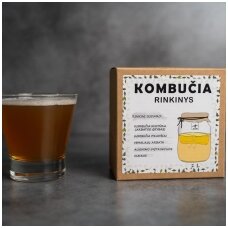How to Flavour Homemade Kombucha?
-

Wondering what to do with leftover teas or other goodies in your home? Use this to flavour your kombucha! Although we recommend using traditional teas such as black tea or green tea for the first fermentation, you can experiment with the second fermentation!
Flavouring homemade kombucha is an art, infusing the drink with new flavours to create a lively symphony for your taste buds. The result is a great-tasting kombucha that will appeal to many kombucha enthusiasts!
Don't forget! Aromatic additives are only added after the primary fermentation to protect the mother culture. Teas such as Earl Grey, flavoured Milky Ulong are classified as flavoured teas and are not suitable for first fermentation as they can damage the tea fungus. We recommend that all additives are used during the second fermentation when the tea fungus is separated from the fermented kombucha. If you put the additives in the same container with the scoby during primary fermentation, you may encounter the following problems:
- Mould
- Tea fungus damage
- Damaging the fermentation process
In this post, you will learn how to improve the taste of kombucha and find the right time to do it. You will also understand how to cleverly incorporate berries, various herbs or spices, and other ingredients, so you can make your own flavoured drink!
Here Are a Few Ways to Flavour KombuchaFlavouring Kombucha With Berries
Cranberries, elderberries, or rose hip are a great choice when the weather turns cold, as they are rich in vitamin C, can help fight colds and boost respiratory health. After the first fermentation, when the scoby has been separated, the liquid should be poured into tightly sealed bottles to which you can add fresh or mashed berries of your choice. The sweeter the berries, the less should be added. Hard berries such as cranberries should be crushed for better extraction. Once the berries have been added, the sealed bottles should be left at room temperature for a few days to allow the kombucha to set. If secondary fermentation is very active, it is important to open the bottles and release the gas after 12–24 hours. In the case of active secondary fermentation, the bottles can be placed in the fridge for up to a day or, if C02 production is very slow, the bottles can be kept in a warm environment for a longer period. The kombucha will naturally carbonate more quickly if the bottles are laid down, not filled to the top, have a very tight closure, and are shaken from time to time.
Flavouring With Fresh Juice
Flavouring kombucha with your favourite fresh juice is a good way to add natural fruit flavours and a bit of sweetness to the drink. The juice adds a natural sweetness and a variety of fruit flavours to kombucha, making it a refreshing and light drink. You can squeeze the juice yourself or buy high-quality, natural fruit juice. Make sure they do not contain additives or preservatives. And then simply add enough juice to the kombucha to give it the flavour you want. We recommend using up to 5% of the total volume of these additives and following the same procedure as described in the section on flavouring kombucha with berries.
Herbs And Spices
The Kombucha can be seasoned with any of your favourite herbs or spices. For example, during the cold season, you can enjoy the taste of cinnamon, cloves, or ginger. These additives will give your drink not only a special flavour, but also a certain cosiness, which is exactly what you want on gloomy winter evenings. And in the summer, when you're feeling refreshed, try kombucha with mint, elderflower, or thyme. Kombucha can also be flavoured with dried spices, which can be brought in with the teas and fermented with a scoby. Depending on the spices chosen, the fermentation time may also vary. We would like to point out that fermenting herbs rich in essential oils, such as mint, can lead to longer fermentation times and less gas formation.
Flavouring Kombucha With Teas
Wondering how else you could spice up your homemade kombucha? These can be your favourite teas or teas you have left at home - a great way to use them! We also offer varietal teas to give your kombucha an even more unique taste. Please note that without the use of additional additives during the second fermentation, the taste of the kombucha will depend only on the tea chosen. The tastier the tea, the more you can enjoy your kombucha. Another aspect that we highly recommend gourmets try is the ageing of kombucha. After the first fermentation with quality unflavoured teas, the kombucha is bottled and left to mature for at least a few months in the fridge. During this period, the kombucha develops a deeper, more complex flavour and longer-lasting natural carbonation. You can also find quality teas for kombucha here at “Tealure”, creating an even more expressive harmony of taste and aroma. From simple herbal green tea to SUMMER MUSCATEL black tea or even MATCHA GENMAICHA green tea and a variety of other flavours to enhance your kombucha experience! We have created a separate segment in the e-shop, where you will find tea blends created through our many years of experience in the fermentation process, as well as the recommended classic tea varieties that will give your kombucha a unique taste.
So we can see that there are all sorts of ways to flavour kombucha. And that's not all! After trying out the tips in this post, definitely don't limit yourself to them - don't hesitate to look for other unusual combinations! Share your discoveries and enjoy customising kombucha to your taste. Here's to more fun, healthier, and tastier kombucha adventures!







